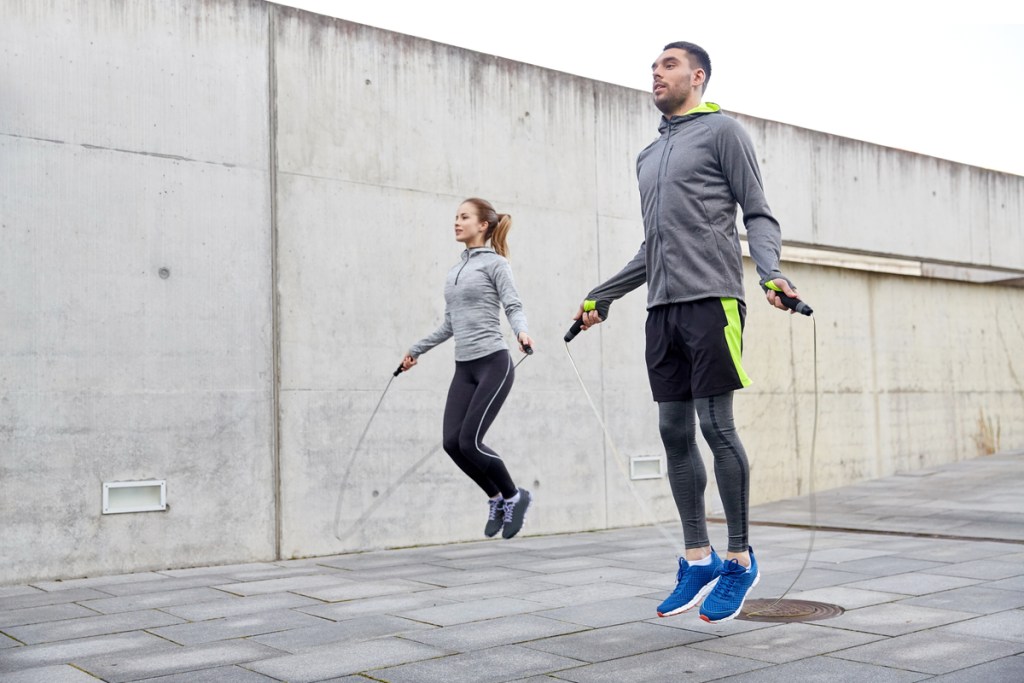
Fitness crazes come and go, but there are a few that seem to stay on the landscape. Running is perhaps the prime example. The CrossFit and high-intensity interval training (HIIT) methodologies that are currently all the rage have put the humble push-up and jumping jack back in the limelight.
And while high-tech hardware like Peleton and Tonal have taken the home workout to a new dimension, another piece of throwback equipment appears to be gaining fresh attention of its own: the jump rope.
If nothing else, most people remember the jump rope from elementary school, but it gaining favor now for its purported health benefits in adults.
There is ample evidence of the positive impact that jumping rope can have (see below), but what about weight loss? Could this basic tool be the key to dropping pounds on the scale? Here we take a close look at jumping rope to determine if it’s all it’s cracked up to be.
The basics
Jump ropes are inexpensive and easy to find online or at just about any big-box store. And it’s just as easy to use, perfect for indoors or out, bedroom or kitchen (just give yourself enough space to turn the rope, and avoid slippery surfaces).
The actual jump is also simple, though to minimize injury and maximize impact, use your wrists to turn the rope, stay on the balls of your feet, and tighten your core for added stability.
There are all sorts of jump-rope workouts available online, including those that involve HIIT methods. As one example, jump rope for 20 seconds, then do pushups for 20 seconds, then rest for 40 seconds in between. As another example, you could simply jump rope for 15 continuous minutes.

What the science says
Lots of scientific studies and fitness experts support the notion that jumping rope is not just fun but seriously beneficial.
As only one example, a 2019 study in the Research Journal of Pharmacy and Technology found that males ages 18-25 years who performed two daily sessions of jump-roping for 12 weeks saw significant improvements in their physical fitness.
In another example, this 2018 study published in the European Journal of Applied Physiology found that 12 weeks of regular rope-jumping improved body composition and cardiovascular disease risk in girls ages 14-16 years.

Does that mean jumping rope can help you lost weight?
Absolutely. It turns out that jumping rope really gets your heart pumping, and that’s the key to any effective weight-loss plan.
In fact, jumping rope is one of the biggest calorie burners out there. Although it’s impossible to pinpoint the exact number of calories each person will burn with a given activity or workout, it is possible to estimate how many calories you’ll expend in an hour. According to one set of estimates, rope jumping burns 720 calories per hour, the same as running 10-minute miles and more than skiing or elliptical training, among others.
The key to any good weight-loss plan is to find something you can stick with. If you loved to jump rope as a kid, you may still enjoy it as an adult. And you’ll really enjoy it if you’re aiming to lose a few pounds, as rope jumping is an extremely effective calorie-burner, not to mention a big helper for the heart and the rest of the body.
Weight loss plans are not made solely of one thing. Make sure to pair your physical activity with a nutrition plan you’re equally sure you can stick with over time. And there’s no need to handcuff yourself to one activity; rope-jumping can be part of a rotating cast of exercises that help you keep things fresh and fun. And as always, be sure to check with your health care professional before you embark on any plan.
BlissMark provides information regarding health, wellness, and beauty. The information within this article is not intended to be medical advice. Before starting any diet or exercise routine, consult your physician. If you don’t have a primary care physician, the United States Health & Human Services department has a free online tool that can help you locate a clinic in your area. We are not medical professionals, have not verified or vetted any programs, and in no way intend our content to be anything more than informative and inspiring.




